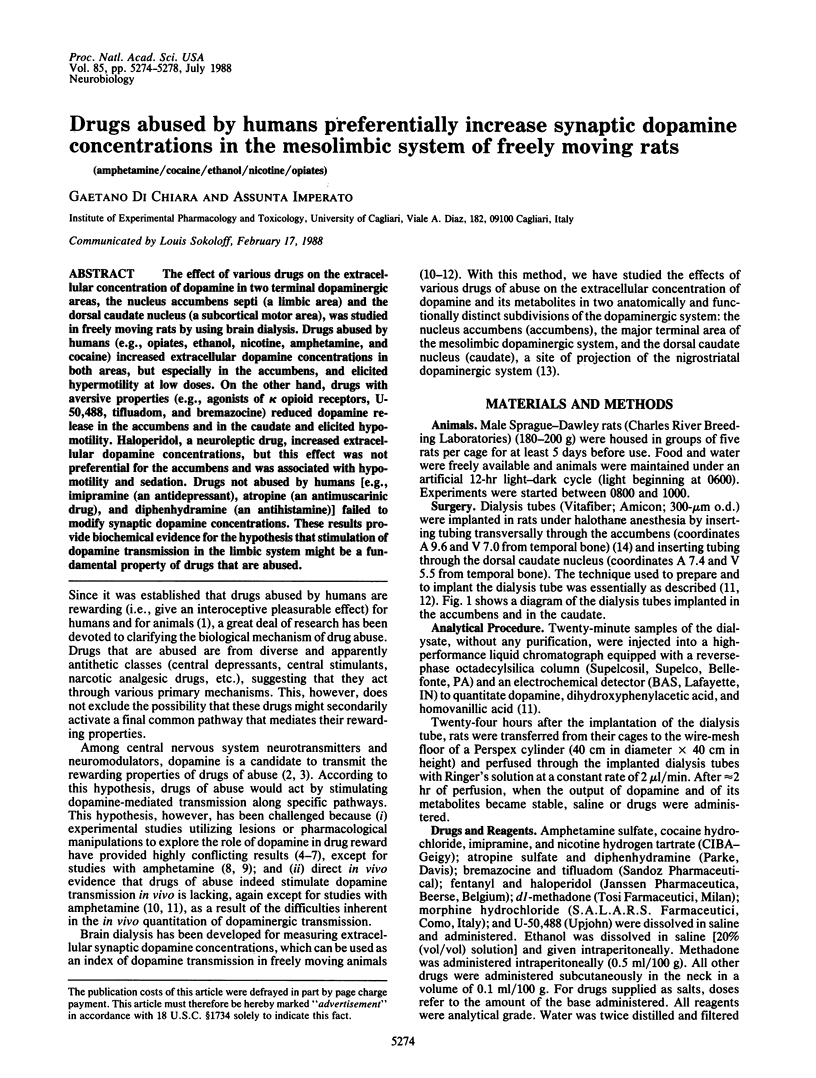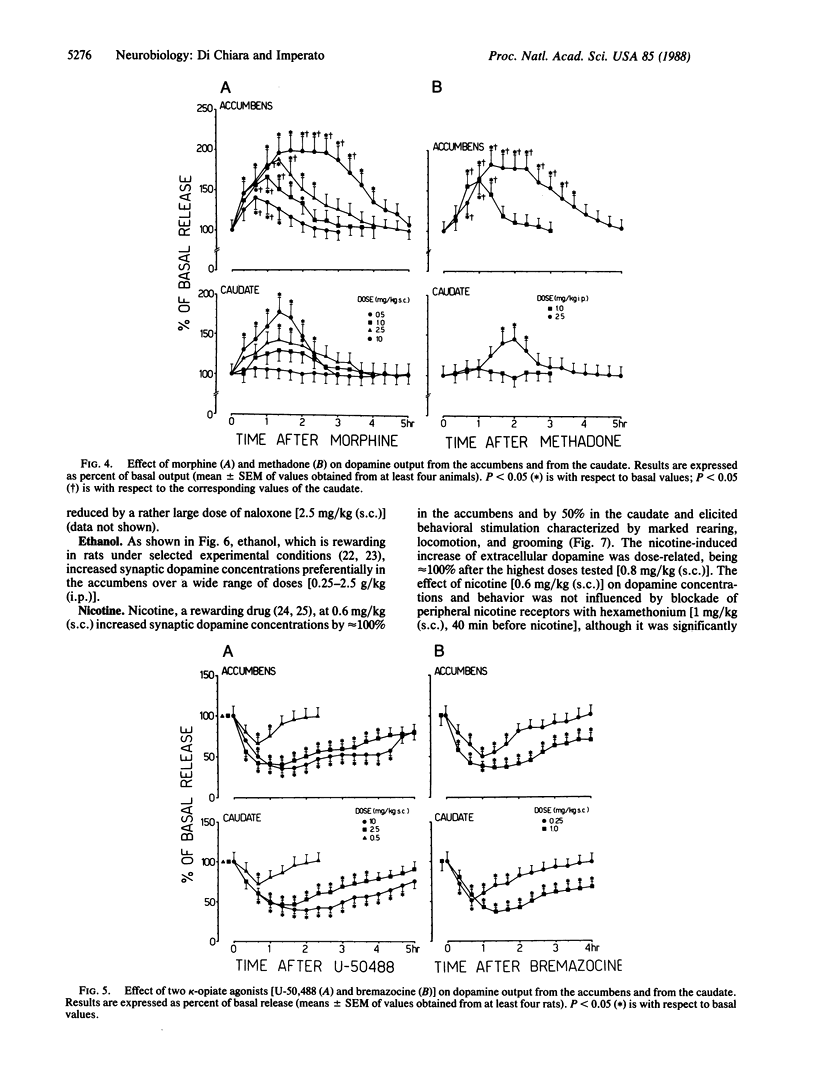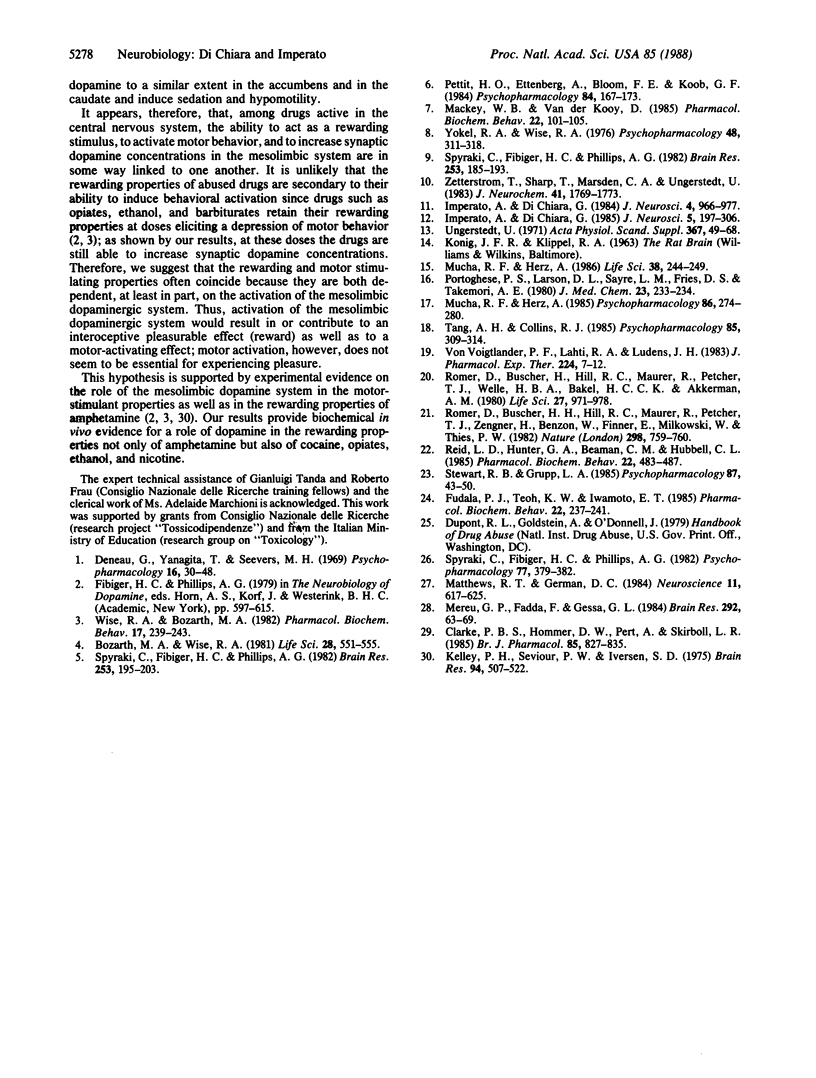Abstract
The effect of various drugs on the extracellular concentration of dopamine in two terminal dopaminergic areas, the nucleus accumbens septi (a limbic area) and the dorsal caudate nucleus (a subcortical motor area), was studied in freely moving rats by using brain dialysis. Drugs abused by humans (e.g., opiates, ethanol, nicotine, amphetamine, and cocaine) increased extracellular dopamine concentrations in both areas, but especially in the accumbens, and elicited hypermotility at low doses. On the other hand, drugs with aversive properties (e.g., agonists of kappa opioid receptors, U-50,488, tifluadom, and bremazocine) reduced dopamine release in the accumbens and in the caudate and elicited hypomotility. Haloperidol, a neuroleptic drug, increased extracellular dopamine concentrations, but this effect was not preferential for the accumbens and was associated with hypomotility and sedation. Drugs not abused by humans [e.g., imipramine (an antidepressant), atropine (an antimuscarinic drug), and diphenhydramine (an antihistamine)] failed to modify synaptic dopamine concentrations. These results provide biochemical evidence for the hypothesis that stimulation of dopamine transmission in the limbic system might be a fundamental property of drugs that are abused.
Full text
PDF




Selected References
These references are in PubMed. This may not be the complete list of references from this article.
- Bozarth M. A., Wise R. A. Intracranial self-administration of morphine into the ventral tegmental area in rats. Life Sci. 1981 Feb 2;28(5):551–555. doi: 10.1016/0024-3205(81)90148-x. [DOI] [PubMed] [Google Scholar]
- Clarke P. B., Hommer D. W., Pert A., Skirboll L. R. Electrophysiological actions of nicotine on substantia nigra single units. Br J Pharmacol. 1985 Aug;85(4):827–835. doi: 10.1111/j.1476-5381.1985.tb11081.x. [DOI] [PMC free article] [PubMed] [Google Scholar]
- Deneau G., Yanagita T., Seevers M. H. Self-administration of psychoactive substances by the monkey. Psychopharmacologia. 1969;16(1):30–48. doi: 10.1007/BF00405254. [DOI] [PubMed] [Google Scholar]
- Fudala P. J., Teoh K. W., Iwamoto E. T. Pharmacologic characterization of nicotine-induced conditioned place preference. Pharmacol Biochem Behav. 1985 Feb;22(2):237–241. doi: 10.1016/0091-3057(85)90384-3. [DOI] [PubMed] [Google Scholar]
- Imperato A., Di Chiara G. Dopamine release and metabolism in awake rats after systemic neuroleptics as studied by trans-striatal dialysis. J Neurosci. 1985 Feb;5(2):297–306. doi: 10.1523/JNEUROSCI.05-02-00297.1985. [DOI] [PMC free article] [PubMed] [Google Scholar]
- Imperato A., Di Chiara G. Trans-striatal dialysis coupled to reverse phase high performance liquid chromatography with electrochemical detection: a new method for the study of the in vivo release of endogenous dopamine and metabolites. J Neurosci. 1984 Apr;4(4):966–977. doi: 10.1523/JNEUROSCI.04-04-00966.1984. [DOI] [PMC free article] [PubMed] [Google Scholar]
- Kelly P. H., Seviour P. W., Iversen S. D. Amphetamine and apomorphine responses in the rat following 6-OHDA lesions of the nucleus accumbens septi and corpus striatum. Brain Res. 1975 Sep 5;94(3):507–522. doi: 10.1016/0006-8993(75)90233-4. [DOI] [PubMed] [Google Scholar]
- Mackey W. B., van der Kooy D. Neuroleptics block the positive reinforcing effects of amphetamine but not of morphine as measured by place conditioning. Pharmacol Biochem Behav. 1985 Jan;22(1):101–105. doi: 10.1016/0091-3057(85)90492-7. [DOI] [PubMed] [Google Scholar]
- Matthews R. T., German D. C. Electrophysiological evidence for excitation of rat ventral tegmental area dopamine neurons by morphine. Neuroscience. 1984 Mar;11(3):617–625. doi: 10.1016/0306-4522(84)90048-4. [DOI] [PubMed] [Google Scholar]
- Mereu G., Fadda F., Gessa G. L. Ethanol stimulates the firing rate of nigral dopaminergic neurons in unanesthetized rats. Brain Res. 1984 Jan 30;292(1):63–69. doi: 10.1016/0006-8993(84)90890-4. [DOI] [PubMed] [Google Scholar]
- Mucha R. F., Herz A. Motivational properties of kappa and mu opioid receptor agonists studied with place and taste preference conditioning. Psychopharmacology (Berl) 1985;86(3):274–280. doi: 10.1007/BF00432213. [DOI] [PubMed] [Google Scholar]
- Mucha R. F., Herz A. Preference conditioning produced by opioid active and inactive isomers of levorphanol and morphine in rat. Life Sci. 1986 Jan 20;38(3):241–249. doi: 10.1016/0024-3205(86)90309-7. [DOI] [PubMed] [Google Scholar]
- Pettit H. O., Ettenberg A., Bloom F. E., Koob G. F. Destruction of dopamine in the nucleus accumbens selectively attenuates cocaine but not heroin self-administration in rats. Psychopharmacology (Berl) 1984;84(2):167–173. doi: 10.1007/BF00427441. [DOI] [PubMed] [Google Scholar]
- Portoghese P. S., Larson D. L., Sayre L. M., Fries D. S., Takemori A. E. A novel opioid receptor site directed alkylating agent with irreversible narcotic antagonistic and reversible agonistic activities. J Med Chem. 1980 Mar;23(3):233–234. doi: 10.1021/jm00177a002. [DOI] [PubMed] [Google Scholar]
- Reid L. D., Hunter G. A., Beaman C. M., Hubbell C. L. Toward understanding ethanol's capacity to be reinforcing: a conditioned place preference following injections of ethanol. Pharmacol Biochem Behav. 1985 Mar;22(3):483–487. doi: 10.1016/0091-3057(85)90051-6. [DOI] [PubMed] [Google Scholar]
- Römer D., Büscher H. H., Hill R. C., Maurer R., Petcher T. J., Zeugner H., Benson W., Finner E., Milkowski W., Thies P. W. An opioid benzodiazepine. Nature. 1982 Aug 19;298(5876):759–760. doi: 10.1038/298759a0. [DOI] [PubMed] [Google Scholar]
- Römer D., Büscher H., Hill R. C., Maurer R., Petcher T. J., Welle H. B., Bakel H. C., Akkerman A. M. Bremazocine: a potent, long-acting opiate kappa-agonist. Life Sci. 1980 Sep 15;27(11):971–978. doi: 10.1016/0024-3205(80)90107-1. [DOI] [PubMed] [Google Scholar]
- Spyraki C., Fibiger H. C., Phillips A. G. Attenuation by haloperidol of place preference conditioning using food reinforcement. Psychopharmacology (Berl) 1982;77(4):379–382. doi: 10.1007/BF00432775. [DOI] [PubMed] [Google Scholar]
- Spyraki C., Fibiger H. C., Phillips A. G. Cocaine-induced place preference conditioning: lack of effects of neuroleptics and 6-hydroxydopamine lesions. Brain Res. 1982 Dec 16;253(1-2):195–203. doi: 10.1016/0006-8993(82)90686-2. [DOI] [PubMed] [Google Scholar]
- Spyraki C., Fibiger H. C., Phillips A. G. Dopaminergic substrates of amphetamine-induced place preference conditioning. Brain Res. 1982 Dec 16;253(1-2):185–193. doi: 10.1016/0006-8993(82)90685-0. [DOI] [PubMed] [Google Scholar]
- Stewart R. B., Grupp L. A. Some determinants of the motivational properties of ethanol in the rat: concurrent administration of food or social stimuli. Psychopharmacology (Berl) 1985;87(1):43–50. doi: 10.1007/BF00431776. [DOI] [PubMed] [Google Scholar]
- Tang A. H., Collins R. J. Behavioral effects of a novel kappa opioid analgesic, U-50488, in rats and rhesus monkeys. Psychopharmacology (Berl) 1985;85(3):309–314. doi: 10.1007/BF00428193. [DOI] [PubMed] [Google Scholar]
- Ungerstedt U. Striatal dopamine release after amphetamine or nerve degeneration revealed by rotational behaviour. Acta Physiol Scand Suppl. 1971;367:49–68. doi: 10.1111/j.1365-201x.1971.tb10999.x. [DOI] [PubMed] [Google Scholar]
- Vonvoigtlander P. F., Lahti R. A., Ludens J. H. U-50,488: a selective and structurally novel non-Mu (kappa) opioid agonist. J Pharmacol Exp Ther. 1983 Jan;224(1):7–12. [PubMed] [Google Scholar]
- Wise R. A., Bozarth M. A. Action of drugs of abuse on brain reward systems: an update with specific attention to opiates. Pharmacol Biochem Behav. 1982 Aug;17(2):239–243. doi: 10.1016/0091-3057(82)90076-4. [DOI] [PubMed] [Google Scholar]
- Yokel R. A., Wise R. A. Attenuation of intravenous amphetamine reinforcement by central dopamine blockade in rats. Psychopharmacology (Berl) 1976 Aug 17;48(3):311–318. doi: 10.1007/BF00496868. [DOI] [PubMed] [Google Scholar]
- Zetterström T., Sharp T., Marsden C. A., Ungerstedt U. In vivo measurement of dopamine and its metabolites by intracerebral dialysis: changes after d-amphetamine. J Neurochem. 1983 Dec;41(6):1769–1773. doi: 10.1111/j.1471-4159.1983.tb00893.x. [DOI] [PubMed] [Google Scholar]


